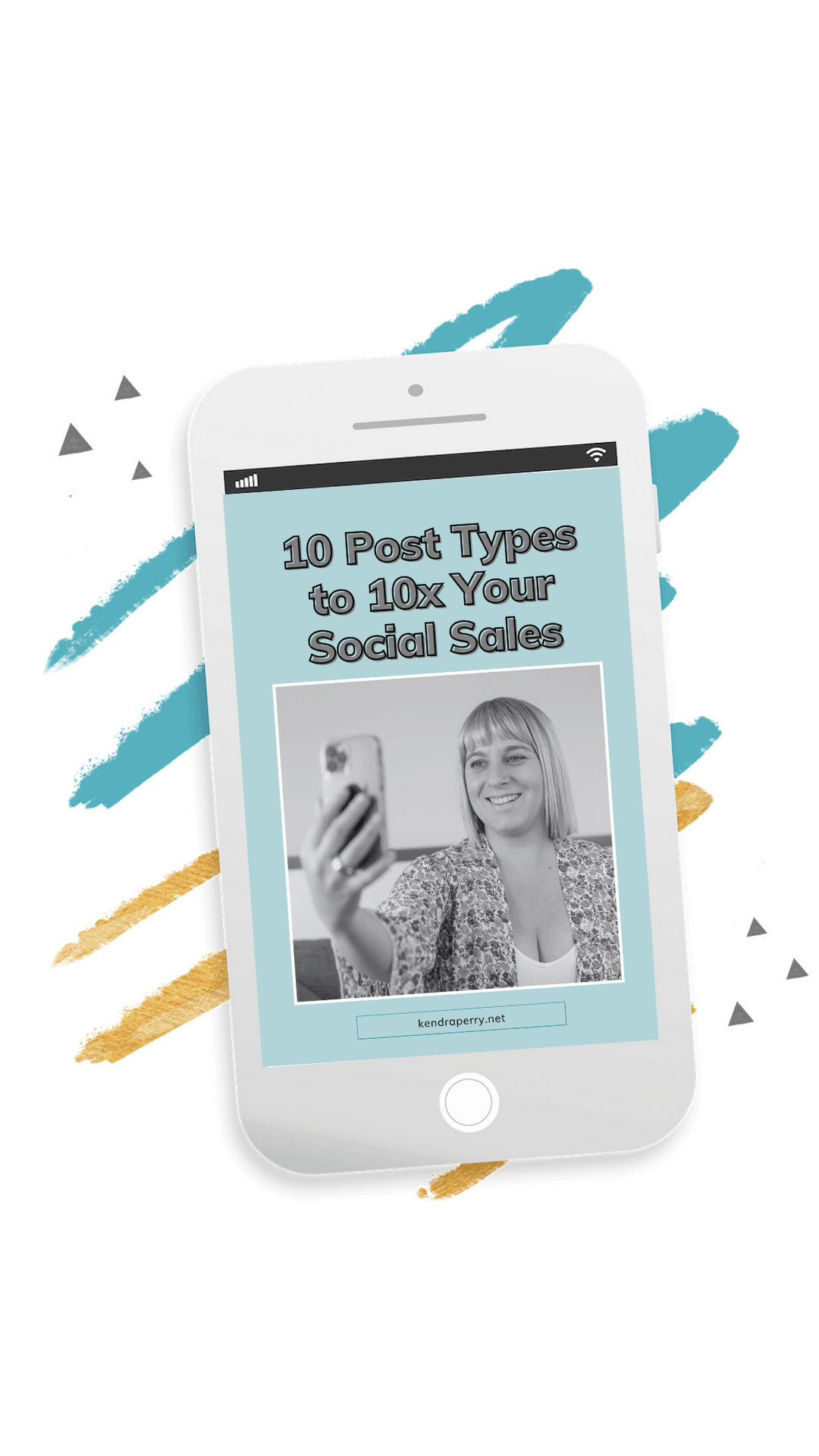Running a business effectively takes well-documented processes. Everyone in the organization needs to know what they’re supposed to do to run seamlessly and optimize productivity. Today, your host Kendra Perry talks about something critical – your company manual. Tune in to understand its value and discover a tool that will help you save time, increase productivity, and save your mental health.
Resources Mentioned in this Episode:
Zapier: https://zapier.com
Trello: https://trello.com
—
Listen to the podcast here
TRIPLE Your Productivity + Save Your Mental Health With This Simple Tool
We are talking about something that is so critical, but not that sexy. We are talking about your company manual. Not that sexy but important because when we talk about organization and productivity, we want to make sure that we have all our systems documented. What I mean by this is what happens when a new client comes into your business? Do they need to get an email? Do they need to get a welcome letter? Do you need to order labs? Do you need to get their personal information? Do you need to get them to sign a contract or a liability waiver? Do they need to get access to Google Drive or a membership area?
What are the exact steps that need to happen for that to occur successfully? When you first start running your business, almost no one talks to you about this. I didn’t have any idea what this was. It was only when I decided to hire a virtual assistant that I realized that I needed to document processes because I was bringing someone into my business, and they needed to know what to do.
I couldn’t tell them to do it because they didn’t know how to do it. I wanted it to be done in a specific way. What I realized is that I had to write down a how-to or an instruction manual for everything that I wanted this virtual assistant to do in my business. I had to spend three weeks working every evening to get everything documented because, at this point, it was two years into my business.
There were a lot of things happening in my business, but all of it was in my brain. It was just in my head. How was I supposed to pass that over to this new person? I realized that I was going to have to document it. That’s when I started to understand the value of a company manual. Not only is it critical to have everything documented like an instruction manual.
When you buy a desk from IKEA, it’s not assembled. When you receive it, you have all these little parts, all these little screws. There’s a lot going on. Imagine IKEA gave that to you and was like, “Good fucking luck.” You had to figure it all out on your own. That would be ridiculous, but you get an instruction manual that says, “Take this part,” and it’s labeled, “Take part A. Attach it to Part B with these screws,” and there’s a little image.
You walk through that entire thing, and your experience of putting together that shelf or desk, whatever we are talking about, was highly dependent on how good that instruction manual is. I don’t know if you’ve ever ordered something where the instruction manual was shitty, and you are so confused. You are like, “This is the worst,” and it takes you ten times as long, versus something that’s clearer and more step-by-step.
That’s what you are doing. You are creating an instruction manual for everything that happens in your business. Again, this is important for being able to bring people into your business because, let’s say, you want to hire a social media manager. Someone who is going to schedule your content, for example. How does that process occur? You could literally bring them in, hire them, and hand them over. Be like, “Here’s the process.” Implement it.
The other reason why this is so critical is for your own time saving because there are some things that we do in our business that we don’t do every day. Maybe we do something monthly. Maybe the first time we did it, we had to figure it out. We did it a month later but four weeks of that have passed, and now we don’t remember how to do it. We are like, “What the fuck? I thought I knew how to do this?” You don’t remember, so then you are relearning it all over again. That’s a huge waste of time.
If you have documented the how-to for that particular task, then all you need to do is refer to your manual to walk yourself through it, so you don’t need to relearn it every time. This is valuable. Every single higher-level business owner that I know has everything documented. This is a huge part of growing and scaling a business because you cannot grow without bringing people into your business. When you are earlier on in your business, it might be you, and that’s cool, but you can’t do that forever if you want to grow or don’t want to work 50 hours a week.

Maybe you want to make $10,000 a month and work 30 or 25 hours a week. You are not going to be able to do that without help. The sooner you can bring people into your business, the better. It opens up more time for not only your freedom, but for you to work on the things that matter in your business. This is something I teach my HCA students. It’s in, I believe, the second module. I basically present it to them early on because as we go through the course, I’m getting them to update their company manual with everything that they are doing.
I know it’s not very sexy. The first time you document something, it is going to take you extra time. It’s an investment of your time so that you can save way more time later. Huge ROI on your time. It’s critical. What are some of the things that can be in a company manual? You want to envision this company manual as something not only that you are going to look at but anyone who decides to work for your business.
Whether they are an online business manager or maybe a social media manager, a virtual assistant, a graphic designer or whoever comes and works into your business, you are probably going to hand over this manual. If you’ve ever had some maybe a corporate job or you’ve worked for a restaurant chain or maybe a sports tour chain, when you go through the onboarding, they typically give you some manual that you are supposed to read. What you will learn is what is the company’s mission statement, maybe what’s the history of the company, what are the company values, all of those things.
You want to do the same thing for your business. The first thing that might be in your company manual is simply your niche statement. Maybe you will have your mission statement. Maybe you will have your company values, for example. What are the company values? We value integrity. What does that mean? What does integrity mean for you? These things are open for interpretation.
For example, in my business, we have a bunch of different values but one of our core values is integrity, as I said. In my opinion, integrity means that you do what you say you are going to do and you take responsibility when you fuck up. You don’t blame anything else. You don’t blame tech. You don’t blame other people. You recognize and admit that you are wrong. You take accountability and fix the issue, and move forward. Don’t make that same mistake again. Put things in place so that mistake doesn’t happen again.
That’s what integrity means for my business. That would be important for anyone coming to work in my business to know. They are going to know, “When I fuck up, it’s not a big deal. I have to take accountability for it and not blame it. Tell people I fucked up and put steps in place so that it doesn’t happen again.” These are good things for anyone who’s coming into your business to know.
Other things you would want in your company manual or any of your branding details. What fonts do you use? What colors do you use? What’s the brand personality? What are your values? As I said, you would want all that stuff to be in there too, because sometimes, if I’m going to hire a graphic designer who’s going to do maybe my Instagram graphics, are going to need to know my fonts, my colors, any brand shapes that I have. I don’t want to have to keep giving them to them every time.
I don’t want to have to find those and copy and paste them. It’s like, “Here’s the company manual. You will find it in there.” Other things that you might want in there are, where do you store everything? Do you use Dropbox? Do you use Google Drive? Do you use Amazon? How do you communicate with team members? Do you communicate through email or do you use something like Slack? Which is an instant messenger app for teens. What’s the response time?
If I email a team member, when do I expect to hear back? 24 hours, by the end of the day or a few hours. What’s your refund policy? If you had a virtual assistant come and work for you, and maybe they are going to be answering emails in your support inbox, they are going to need to know your refund policy because they will be the ones receiving refund requests.
You don’t want to have to type it out and remind them every time. You say, “Refer to the company manual. There’s the refund policy.” The other things you want in there are all the step-by-step how-to. Again, we talked about this at the beginning. What does that onboarding process look like? Maybe the first thing that happens is payment is processed, and then we send them a contract, a waiver, and a welcome letter.
Once the contract was signed, we ordered the labs. We send them a login for the membership area or we give them the Google Drive link. We set up their first appointment. Whatever it is, exactly what that process looks like so that it can be duplicated over and over again. What is your process for creating social media? Do you write the content first, and then maybe you could design the graphics and upload everything to Later.com? This is my favorite social media scheduler.
There are a lot of them. I use Later. You maybe have to upload all the graphics there, and then you have to schedule. Do you want hashtags in that? What do you want it to look like? Do you want the person to edit it for spelling mistakes? Whatever. You want that step-by-step process, even if you don’t have a team member, and then you are duplicating.
How do you want your customer service emails answered? Do you want people to go above and beyond? Do you want to make sure that the person’s name is always used like, “Hey, Jane, or whatever?” Do you want their inquiries to be responded to within a certain timeframe? How quickly are people going to get a response, 24 hours or 48 hours? What is it?
Every single process that you do in your business, you are going to put into your company manual. This is a living, breathing document. It’s living and breathing. Meaning that it’s continually updated as the processes change. For example, my online business manager, Elise. She manages all the day-to-day in my business. This is her responsibility to keep the company manual updated.

That means when we change things, as we do all the time, she needs to update it. One of my rules is that every quarter, she goes in and makes sure everything is up to date. Let’s say you bring in a social media manager. You need to make it a requirement of their contract or employment that they update their process in the manual because maybe they are going to change the process. Maybe they are like, “You are using Later.com to schedule but there’s this other social media scheduler that’s cheaper and works a little bit better.”
You are going to be like, “That sounds,” but they need to update that in the company manual because, let’s say, they get sick or maybe they quit with no notice. They ghost you. It happens, or maybe you need to let them go because they are not doing a good job. You don’t want to be screwed when you bring someone else in.
If you have to hire someone quickly, you don’t want to have to retrain them, reteach them, or rewrite the processes. Ideally, that person would go, and you would bring someone else in and hand them over the instruction manual. Do you see how this greatly increases your time management, your productivity? It saves you so much headache. It saves your mental health too. Let’s be honest.
All of that needs to be in the company manual. The processes need to be updated regularly, and the person who is responsible for each role has to update the manual. What might be helpful is that you give them a timeframe. Maybe at the end of every month, you look over your processes and make sure that nothing has changed. You make sure that it is updated in the company manual. In my business, it’s every quarter.
A cool thing about doing the company manual is that it helps you determine what can be automated in your business. The goal is to automate the business as much as possible. Meaning that everything isn’t a manual task because when it’s manual, either you have to do it or you have to pay someone to do it. There are certain platforms that help you make things happen automatically.
A good example of this is Zapier.com. Essentially, you think of Zapier as the middleman. It connects different software and platforms that we wouldn’t normally talk about. Let’s say that you want to send out recordings to all your clients. They have a one-on-one session with you, and one of the agreements is that they are going to get the recording of the meeting.
Maybe what you are doing is, after that meeting, you are going into Zoom. You are waiting for it to process. You are downloading it and uploading it into Google Drive. That might only take you 5 minutes or 10 minutes but if you are doing that for a whole bunch of different clients, then that’s going to be a problem. Over the time span of a year, that could be hundreds of minutes or even multiple hours.
It could even be 40 hours, which is a whole week off. That’s your vacation time for the year. When you look at your step-by-step instructional manual, especially with things like social media or onboarding, try to figure out, “Can this be automated?” What Zapier will do is you can set it up. When this happens, do this. When something is downloaded or recorded to Zoom into the cloud, you can automatically add it to a Google Drive folder, so you don’t have to worry about downloading and uploading it. All you need to do is go in there and give the person the share link.
There’s still a little bit of manual but that is a lot quicker than doing all the other things. You want to try to figure out, “What can I automate?” Anything you are doing manually, check it out in Zapier and check if there’s a Zap for that. If something can happen without you involved because that is always the goal. It’s hard to know what you can automate when you don’t understand the entire process.
You need to be able to look at it and determine, “This could be automated.” The goal is to automate as much as possible and hire out for the rest. The entire onboarding process probably can’t be automated if we are talking about, say, one-on-one coaching. If we are talking about group coaching, a lot more can be automated but there are still going to be some manual things.
For example, when you join HCA, you are going to get access to a Facebook group. We can’t automatically add you to a Facebook group. That needs to happen manually. My virtual assistant does that. That’s a manual task. Again, that’s documented in our company manual, but what does happen automatically is when you buy HCA, you are automatically going to get access to the course. You are automatically going to get our onboarding emails that help get you familiarized with the course and get you to do all the things that you need to do to get yourself set up. That all happens automatically.
The manual part is basically adding you to the Facebook group. We basically have this little card inside a platform called Asana. We put a due date on it because you are going to get six months of access to the live coaching part of the course. The weekly reviews, our weekly group coaching calls, our Facebook group, and all of those things which is fantastic but after six months, it expires.
At that point, either you are going to be complete or continue to pay on a membership basis. At six months, we need that deadline because my assistant needs to look at that and check, “Did you buy continuing support?” You didn’t. Send out an email, “You are going to be losing your access. Is this something you want to continue to have?”
If you don’t decide to purchase, then we need to remove you from the Facebook group. We need to delete certain tags. Hopefully, that makes sense. We want to automate as much as possible, and we can hire out for the rest. You don’t want to be paying people to do something that could be automated for a basically free or much lower price.

Your homework for this episode is to start your company manual. Where do you start it? There are a few different ways you can do it. The easiest way is to use a simple Word document or a Google document. I prefer a Google document because it has a good search feature. If you hit command on your keyboard and then Command F, it will pull up a little search box, and you can search the documents. You don’t need to scroll through it every time.
Maybe you are like, “How do I start a Zoom meeting?” Control F, type in Zoom, and it will show you everywhere Zoom shows up in your company manual. I started my manual with a Google document and then moved it into a platform called Trello. Trello is a project management software. Basically, it’s very visual. We put it into there.
I love Trello. I recommend it for my students because you can basically use it for free up to a certain number of boards. Now, we’ve moved our manual into a platform called Asana. It’s very similar to Trello. The difference is that it’s more functional for teams when there are multiple people working on the same board. We use Asana. Asana is a little bit more technical. It’s not as user-friendly. It took me a bit of time to learn.
If you are not very techy, I recommend Trello. There are other ones too. There’s Monday, which I’ve heard good things about. Full disclaimer, I’ve not used it. There’s something called Notion. There’s something called ClickUp. There are all these different ways you can host it, and my students inside HCA get a company manual template inside Trello that they can use.
Your goal or homework is to work either with Trello or Google Documents or Word document. You are going to start your company manual. I know it’s going to be a little bit of work because maybe you are a year or two into your business. You are like, “Kendra, I haven’t documented anything.” It’s going to take you a bit of time. Know that there is a huge ROI for your time, Return on Investment.
You will spend a little bit more time getting this set up, but it’s going to give you so much more time in the long run. Plus, it’s going to make it much easier for people to come and help you out in your business. I hope you enjoyed this episode. If you want to give me a five-star review, I would more than love that.
You can scroll down on your Apple Podcasts app, and give me a little bit of a review. If you feel like that’s maybe a bit too time-consuming, which I get, make sure you are subscribed to the show on whatever app you’re using and download the first three episodes because that alone does so much to support this show. It will only take you maybe 10 or 15 seconds. I hope you have an amazing day. I will see you on the next episode at the same time and place where I help you become wealthy AF.
Important Links






